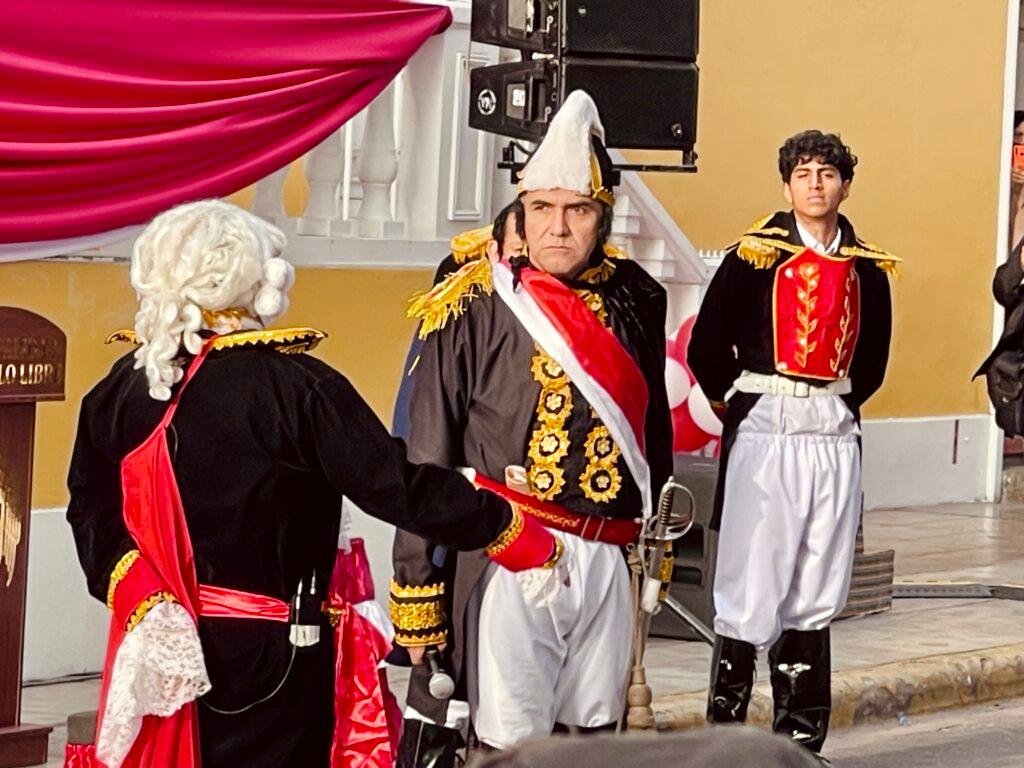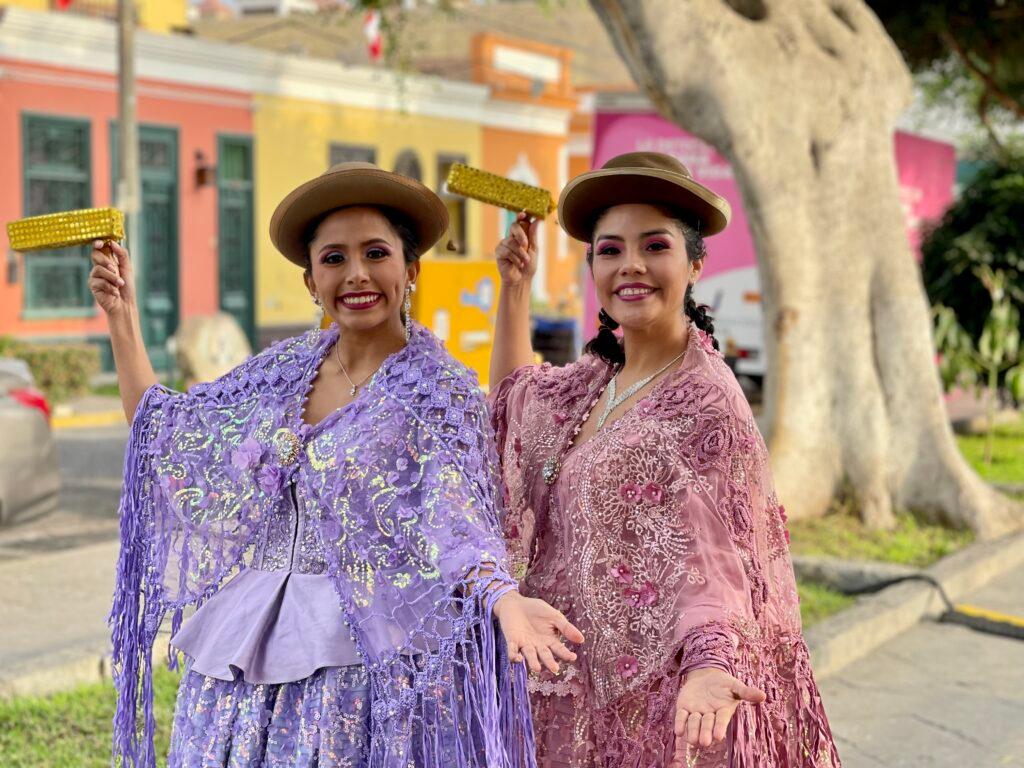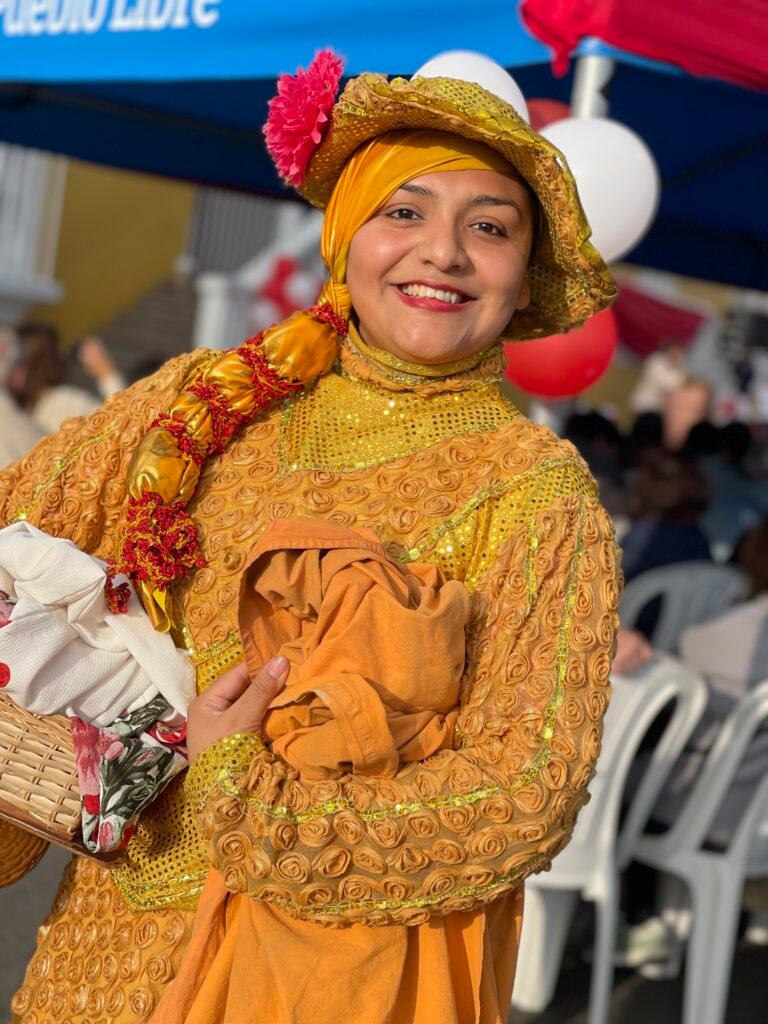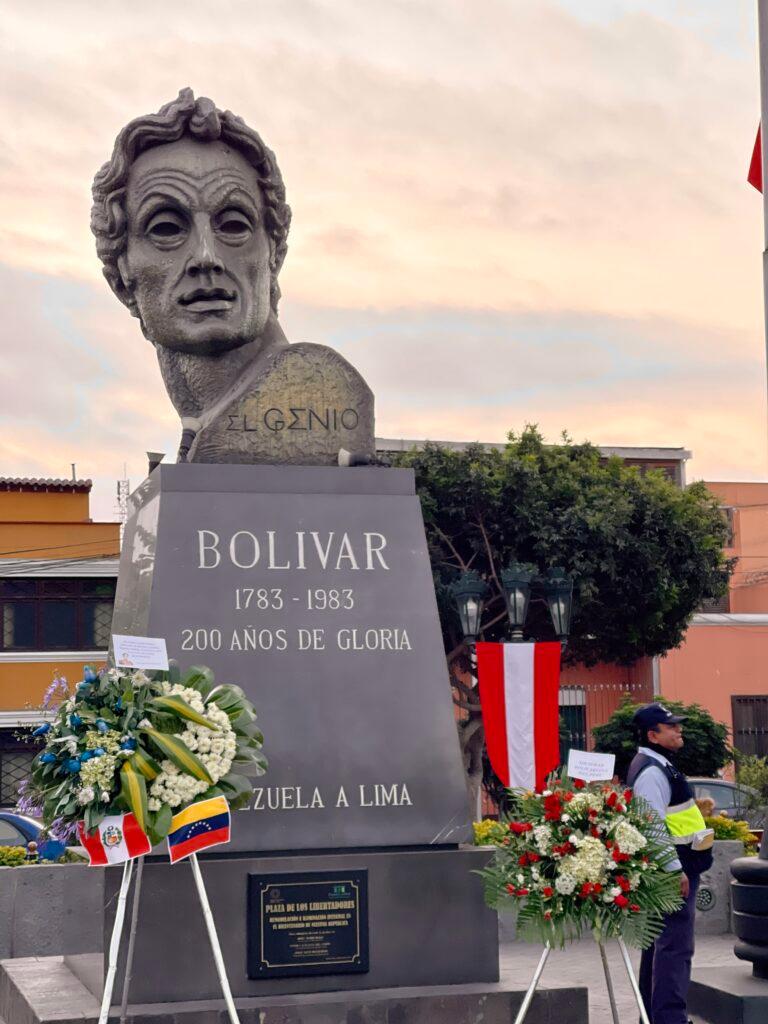Welcome to Pueblo Libre Lima, your essential guide to a district where history, food, and vibrant nightlife converge. This isn’t a sleepy residential area. It’s a dynamic part of Lima offering an authentic journey through Peru’s past and present.
Why Pueblo Libre is a Must-Visit:
Pueblo Libre holds immense historical significance for Peru. And the rest of South America. It’s a district where pivotal historical figures like Simon Bolívar, Jose de San Martín, Antonio José de Sucre and Manuela Sáenz once lived. And where republican-era buildings stand alongside modern life.
Our site highlights the must-see tourist attractions that bring this rich history to life. Explore the vast collections of the National Museum of Archaeology, Anthropology, and History of Peru, a window into millennia of Peruvian civilization. Discover the Museo Arqueológico Rafael Larco Herrera, an exquisite museum known for its pre-Columbian art. These sites aren’t just relics; they’re vibrant points of connection to Peru’s enduring legacy.
Beyond history, Pueblo Libre boasts an electrifying food scene. Dive into authentic Peruvian cuisine, from traditional ceviche and lomo saltado at local eateries, or in Lima’s oldest bar and restaurant, to innovative dishes that reflect Lima’s modern culinary spirit. Every meal here in Pueblo Libre is a taste of Peru’s soul.
As evening falls, Pueblo Libre comes alive with its dynamic nightlife. Enjoy traditional bars for a classic pisco sour, or find energetic spots buzzing with local music and conversation. It’s an authentic taste of Lima after dark, distinct from the city’s more tourist-centric areas.
Pueblo Libre is an exhilarating exploration of Peruvian identity—a place where the echoes of history meet contemporary energy, creating an unforgettable travel experience.




Historic tourist attractions in Pueblo Libre
- Plaza Bolívar
- Quinta de los Libertadores (Magdalena Palace)
- National Museum of the Archaeology, Anthropology, and History of Peru
- Larco Museum
- Boulevard del Criollismo
- Santiago Queirolo
- Antigua Taberna Queirolo
- Santa María Magdalena
- La Cruz del Viajero
- El Ombú
- Plaza de la Bandera
- Complejo Arqueológico Mateo Salado
- Huaca Julio C. Tello
- Paseo de los Vecinos Ilustres de Pueblo Libre
Museums in Pueblo Libre, Lima
- Larco Museum
- National Museum of the Archaeology, Anthropology, and History of Peru, Lima
- Quinta de los Libertadores
Minor Museums in Pueblo Libre
- Casa Cultural Manuelita Saenz
- Casa Museo Julia Codesido
- Casa Hacienda Orbea
- Sala de exposición Duccio Bonavia (part of the Mateo Salado Archaeological Complex)
Future Museums in Construction
- National Museum of the Archaeology, Anthropology, and History of Peru (MNAAHP) is being remodeled and extended. It will be several times larger when finished.
- Archivo General de la Nación (General Archive of the Nation) is being relocated to a new complex in Pueblo Libre.
Pueblo Libre: The ‘Villa de los Libertadores’
Pueblo Libre, which translates to ‘Free Town,’ is a name bestowed upon the district in recognition of its unwavering patriotism during Peru’s fight for independence. It’s often called the ‘Villa de los Libertadores,’ a title it earned by serving as the headquarters and home for many of the key figures who shaped the country’s destiny. For any history lover visiting Lima, this district is where the heartbeat of liberty can be felt most profoundly.
A Love Story Etched in Stone
The story of Pueblo Libre is beautifully symbolized by the passionate and enduring relationship between Simón Bolívar and the formidable Manuela Sáenz. Their love story, one of the most famous in South American history, unfolded in the very streets and homes of this district.
Today, in Plaza Bolívar, you’ll find a bronze statue of the great liberator. However, this isn’t just any monument. The statue is deliberately positioned, with Bolívar looking back over his shoulder across the plaza, directly at the location of Sáenz’s former home. This poignant detail immortalizes their bond and stands as a testament to her crucial, yet often overlooked, role in the fight for freedom.
Famous Residents and Historical Figures
Pueblo Libre has been the temporary or permanent home to some of the most influential figures in Peruvian history. The district’s historical significance is directly tied to the presence of these individuals who left an indelible mark not just on this nation, but on the entire continent of South America.
- José de San Martín: The Liberator of the South, who declared Peru’s independence in Lima’s Plaza Mayor. Which he planned from his headquarters in Pueblo Libre’s Quinta de los Libertadores.
- Simón Bolívar: The Liberator of the North, who also resided in the Quinta while strategizing the final campaigns for independence.
- Antonio José de Sucre: Grand Marshal of Ayacucho and the 1st President of Bolivia, lived in Pueblo Libre between 1823 and 1825.
- Manuela Sáenz: The ‘Libertadora del Libertador,’ whose house stood in Pueblo Libre, making her a central figure in the district’s revolutionary history.
- Joaquín de la Pezuela: The last Spanish viceroy to use the Quinta as his personal residence before the arrival of the liberating armies.
- Gonzalo Taulichusco: The last Tribal Chief of the local people, who donated the land for the Santa María Magdalena Church.
Note: There are many more. And you can find out about their histories by visiting Paseo de los Vecinos Ilustres de Pueblo Libre (Basically, in english it’s the street of ‘famous neighbors’). Or, Boulevard de las Patricias ( Street of Patriarchs and Heroines).
Getting to Pueblo Libre
Pueblo Libre is conveniently located halfway between the Jorge Chávez International Airport and Miraflores. It’s bordered by Magdalena del Mar, Jesus Maria, San Miguel and San Isidro.
Getting to Pueblo Libre is easy. You can get an Uber (or inDrive, DiDi or Cabify) from the airport, Miraflores or Barranco. And an Uber will take 20-30 minutes and cost roughly $5. Door to door private car services with english speaking drivers are available for under $20.
Note: Pueblo Libre is set to get 2 or more metro stations as part of the Lima Metro Line 2. And these will be completed and operational before 2028. Making Pueblo Libre even cheaper and easier for tourists to visit.
Safety in Pueblo Libre
Pueblo Libre is consistently rated as one of the safest districts in Lima. As of 2025, Pueblo Libre is currently rated as the 3rd safest district in Lima (out of 43 districts). And it boasts higher levels of safety and security than Miraflores or Barranco, as shown by the Peruvian Government’s own INEI crime statistics.
With the two best museums in Lima that are housing the largest collections of priceless artefacts, along with a large number of protected sites of Peruvian Cultural Heritage, there comes comparatively higher levels of safety and security.
Yet, Pueblo Libre is also home to the Bolivar Barracks (Cuartel Bolívar), housed in a beautiful art deco building less than 1 block from Plaza Bolivar. And criminals typically don’t want to ply their crafts in places where they might stumble into a contingent of special forces soldiers.
Pueblo Libre also utilizes a sophisticated modern network of live monitored CCTV cameras and drones. And local residents all have free access to a mobile application panic button, called Alerta Pueblo Libre, that summons the police and the serenazgo (neighborhood security force) in an emergency.
It’s also worth mentioning again that Pueblo Libre is bordered by Jesus Maria, Magdalena del Mar and San Isidro. All of which are in the top 10 safest districts in Lima with Pueblo Libre.
Fun fact: Pueblo Libre boast a high Human Development Index (0.8337 in 2019). Ranking fifth among all districts in Lima and Peru. And Pueblo Libre has a high coverage of educational (98%) and basic services (99.7%). Even the murder rate in Pueblo Libre Lima is worth mentioning; It’s 0.1 per 100k residents, so compare that to your own home city.
Languages Spoken in Pueblo Libre
Spanish is the dominant language in Peru. Yet there’s a misconception among english speaking tourists that only in Miraflores and Barranco will they find local Peruvians who can speak english. And this is simply not true.
Pueblo Libre and neighboring Jesus Maria are home to many universities and university language schools. Including the Pontifical Catholic University of Peru. Which is Peru’s highest rated university.
Among the youth in Pueblo Libre, english is a common second language. And among businesses and at sites of tourist interest in Pueblo Libre, there will be people who can speak english and many who are studying english at nearby universities and language schools.
Pueblo Libre, Jesus Maria and Magdalena del Mar are also home to a growing number of digital nomads, expats and foreign residents. So, don’t be surprised if you hear english, german, french or any number of other languages.
Where to stay in Pueblo Libre, Lima
Most visitors to Pueblo Libre choose to stay in private holiday rentals that they obtain through applications like Airbnb and VRBO. And the most popular part of Pueblo Libre for accommodation, particularly of the type sought by tourists, international students and digital nomads is around Parque Gianoli in the Colmenares (Sector 5) area. In Pueblo Libre and the rest of Lima, private apartment rentals more often represent better value and greater convenience.
Yet there are hotels present in Pueblo Libre. And you can find them on Google or through hotel reservation websites. There are however no backpacker or party hostels or boutique hotels in Pueblo Libre. These types of accommodations are located in neighbouring districts of Lima.
Shopping in Pueblo Libre
Pueblo Libre has 3 traditional Peruvian markets, supermarkets and easy access to some of the biggest malls in Lima. It also has some of the best souvenir shopping in Lima.
For fruits, nuts, vegetables or meat, visit either Mercado de Pueblo Libre or the Simon Bolivar Market in Pueblo Libre. For houseplants or other nicknacks, visit the Andalucía Market. Yet, for souvenir shopping in Lima, visit the Gran Mercado Inka in Pueblo Libre.
Now, for upscale multistory western style shopping malls, visit Plaza San Miguel or Real Plaza Salaverry. Both are absolutely massive, but Plaza San Miguel is the biggest. Plaza San Miguel has everything from luxury goods and cinemas to indoor ice skating.
It’s also worth mentioning that the mobile applications Rappi and PedidosYa do work in Pueblo Libre. And you can have food, groceries and other goods delivered to your door in minutes. Both Rappi and PedidosYa function like Uber Eats.
Travel Tip: The best souvenir shopping in Lima is done in the Gran Mercado Inka in Pueblo Libre. You’ll find every kind of souvenir from all over Peru at wholesale prices. It’s much, much cheaper than the Mercado Indio (Indian Market) in Miraflores. Be sure to check all of the stores in and around the Gran Mercado Inka before purchase, for the best priced souvenirs in Lima.
Tours in Pueblo Libre
Tours do exist in Pueblo Libre. And you can book organised tours of the district and day trips to other districts in Lima and surrounds from Pueblo Libre.
You should consider starting your exploration of Pueblo Libre with a walking tour of the district that traces the footsteps of the revolutionary heros that called Pueblo Libre home. Walking tours of Pueblo Libre will allow you to explore the history of the district and also give you an opportunity to ask questions and gain local insight.
Apart from free walking tours of Pueblo Libre and paid walking tours tracing the steps of Simon Bolivar, Pueblo Libre also has food and cocktail tours, coffee classes with Lima’s best cafes, street art tours and even museum tours with local guides.
Pueblo Libre is more bohemian than Barranco
The very names of Pueblo Libre and Barranco offer a fascinating glimpse into their distinct “bohemian” characters. “Pueblo Libre,” meaning “Free People,” was a name bestowed during Peru’s fight for independence, recognizing the inhabitants’ patriotism and desire for freedom. This foundational idea of liberty and self-determination deeply resonates with the core spirit of bohemianism – a life free from conventional norms, prioritizing artistic expression, and embracing an authentic, less commercialized existence. The pervasive street art and vibrant, yet unpretentious local atmosphere of modern Pueblo Libre, truly embody this historical legacy of freedom and independent spirit.
In contrast, “Barranco” simply means “ravine” or “cliff,” named after its prominent geographical feature. While its picturesque setting and historical separation as a former beach resort for the rich fostered a degree of artistic appeal, its “bohemian” identity has evolved differently. Barranco’s charm now often lies in the historic quarters dramatic beauty, colonial architecture, and a lively, but increasingly very commercialized, arts and nightlife scene.
Unlike Pueblo Libre’s implicit promise of “freedom,” Barranco’s bohemianism is more of a cultivated aesthetic and a popular tourist slogan, often feeling more curated and less rooted in the raw, independent spirit of boheminaism suggested by Pueblo Libre’s very name.

Nightlife in Pueblo Libre
Pueblo Libre is often mistakenly referred to as a ‘sleepy’, ‘quiet’, ‘residential’ district in Lima. It’s as if the authors of such articles are trying to describe Pueblo Libre as boring. And this couldn’t be further from the truth.
There is a vibrant nightlife scene in the district. And it primarily centers on the areas surrounding Plaza Bolivar and Parque 3 de Octubre. Nightlife venues can be found in their highest density for about 2 blocks around these parks. But there are plenty more around the district, if you know where to look.
Now, you can find live music and crowds in Pueblo Libre most nights of the week. Yet Wednesday, Thursday, Friday and Saturday nights are the best. With Friday and Saturday nights often featuring big name live salsa acts until 5am in the Barley Bar (Bolivar Convention Center).

Prices of goods and services in Pueblo Libre
Pueblo Libre is not a tourist trap like Miraflores or Barranco. The prices in Pueblo Libre aren’t inflated by decades of marketing to tourists.
On a night out in Pueblo Libre, you can easily find drink specials that range from s/50 to s/65 ($13.5 to $18 USD), that are all you can drink. And a bucket with 6 beers in a rooftop bar or disco will cost roughly s/55. Yes, you read that right. You’ll be staggering home.
For a meal in a top tier restaurant, you can expect to spend anywhere from s/60 to s/200 ($16.50 to $54.50) per person. And this will include a minimum of 3 courses and 2 drinks.
Accommodation is where it gets tricky in Pueblo Libre. The district is height restricted in most locations. Meaning that you won’t find modern shoebox studio apartments in huge buildings on Airbnb. So in Pueblo Libre, it’s the accommodation that will cost you the most. Yet accommodation costs in Pueblo Libre will cheaper than the tourist traps of Miraflores and Barranco. And the apartments in Pueblo Libre will often be better equipped for tourists seeking to stay longer in Lima.
Overall, taking into consideration food, drink and accommodation, you will spend significantly less in Pueblo Libre than you would by staying in Miraflores or Barranco. Yet, you’ll have a lot more to see and do!
So, if you’re a budget traveller, digital nomad, slow traveller or international student visiting Peru, you should definitely consider staying in Lima’s safest, most secure and most bohemian, historically significant tourist district – Pueblo Libre!
Paying for goods and services in Pueblo Libre
All but the smallest street vendors and market vendors will accept card payments and payments via mobile tap and go. You don’t need to carry lots of cash. Along Antonio José de Sucre avenue, all around Plaza Vea and in the Andalucía market you will find currency exchanges, banks and international transfer services.
If you’re using a foreign bank card in Peru and you want to get cash out, your two best options are Banco de la Nación and Western Union. Banco de la Nación is fee free for most foreign cards. And Western Union allows you to send yourself money for a fixed fee that is often times cheaper than other banks in Peru.
Now, most digital nomads, expats and foreign students seem to know about Wise in Peru, but often the tourists don’t. So it’s worth repeating here. Using Wise for tap and go payments in Peru is the cheapest way of paying for goods and services. Wise is free to start, free to load and it uses the real mid-market exchange rate with no hidden fees.
Tourist information about Pueblo Libre in Lima
There’s many places you can get more information about visiting Pueblo Libre and Lima. But not all of the authors have spent any real amount of time in the Pueblo Libre neighborhood. And most have out of date information and pictures from a decade ago.
With that said, those websites linked below are updated regularly and have current information. We recommend you subscribe to the following blogs, websites and facebook groups:
- Pueblo Libre Tourism Facebook Group
- Pueblo Libre Pinterest
- Pueblo Libre TikTok
- Pueblo Libre Lima Instagram
- Pueblo Libre Lima Facebook Page
- Pueblo Libre Pictures on UnSplash
- Pueblo Libre on TripAdvisor
- In Lovely Blue
- Just Cruising Around
Note: If you’ve got a current article about Pueblo Libre in Lima that you think should be linked here, get in touch via the Pueblo Libre Tourism Facebook Group.
Welcome to Pueblo Libre Lima, your essential guide to a district where history, food, and vibrant nightlife converge. This isn’t a sleepy residential area. It’s a dynamic part of Lima offering an authentic journey through Peru’s past and present.
Why Pueblo Libre is a Must-Visit:
Pueblo Libre holds immense historical significance for Peru. And the rest of South America. It’s a district where pivotal historical figures like Simon Bolívar, Jose de San Martín, Antonio José de Sucre and Manuela Sáenz once lived. And where republican-era buildings stand alongside modern life.
Our site highlights the must-see tourist attractions that bring this rich history to life. Explore the vast collections of the National Museum of Archaeology, Anthropology, and History of Peru, a window into millennia of Peruvian civilization. Discover the Museo Arqueológico Rafael Larco Herrera, an exquisite museum known for its pre-Columbian art. These sites aren’t just relics; they’re vibrant points of connection to Peru’s enduring legacy.
Beyond history, Pueblo Libre boasts an electrifying food scene. Dive into authentic Peruvian cuisine, from traditional ceviche and lomo saltado at local eateries, or in Lima’s oldest bar and restaurant, to innovative dishes that reflect Lima’s modern culinary spirit. Every meal here in Pueblo Libre is a taste of Peru’s soul.
As evening falls, Pueblo Libre comes alive with its dynamic nightlife. Enjoy traditional bars for a classic pisco sour, or find energetic spots buzzing with local music and conversation. It’s an authentic taste of Lima after dark, distinct from the city’s more tourist-centric areas.
Pueblo Libre is an exhilarating exploration of Peruvian identity—a place where the echoes of history meet contemporary energy, creating an unforgettable travel experience.




Historic tourist attractions in Pueblo Libre
- Plaza Bolívar
- Quinta de los Libertadores (Magdalena Palace)
- National Museum of the Archaeology, Anthropology, and History of Peru
- Larco Museum
- Boulevard del Criollismo
- Santiago Queirolo
- Antigua Taberna Queirolo
- Santa María Magdalena
- La Cruz del Viajero
- El Ombú
- Plaza de la Bandera
- Complejo Arqueológico Mateo Salado
- Huaca Julio C. Tello
- Paseo de los Vecinos Ilustres de Pueblo Libre
Museums in Pueblo Libre, Lima
- Larco Museum
- National Museum of the Archaeology, Anthropology, and History of Peru, Lima
- Quinta de los Libertadores
Minor Museums in Pueblo Libre
- Casa Cultural Manuelita Saenz
- Casa Museo Julia Codesido
- Casa Hacienda Orbea
- Sala de exposición Duccio Bonavia (part of the Mateo Salado Archaeological Complex)
Future Museums in Construction
- National Museum of the Archaeology, Anthropology, and History of Peru (MNAAHP) is being remodeled and extended. It will be several times larger when finished.
- Archivo General de la Nación (General Archive of the Nation) is being relocated to a new complex in Pueblo Libre.
Pueblo Libre: The ‘Villa de los Libertadores’
Pueblo Libre, which translates to ‘Free Town,’ is a name bestowed upon the district in recognition of its unwavering patriotism during Peru’s fight for independence. It’s often called the ‘Villa de los Libertadores,’ a title it earned by serving as the headquarters and home for many of the key figures who shaped the country’s destiny. For any history lover visiting Lima, this district is where the heartbeat of liberty can be felt most profoundly.
A Love Story Etched in Stone
The story of Pueblo Libre is beautifully symbolized by the passionate and enduring relationship between Simón Bolívar and the formidable Manuela Sáenz. Their love story, one of the most famous in South American history, unfolded in the very streets and homes of this district.
Today, in Plaza Bolívar, you’ll find a bronze statue of the great liberator. However, this isn’t just any monument. The statue is deliberately positioned, with Bolívar looking back over his shoulder across the plaza, directly at the location of Sáenz’s former home. This poignant detail immortalizes their bond and stands as a testament to her crucial, yet often overlooked, role in the fight for freedom.
Famous Residents and Historical Figures
Pueblo Libre has been the temporary or permanent home to some of the most influential figures in Peruvian history. The district’s historical significance is directly tied to the presence of these individuals who left an indelible mark not just on this nation, but on the entire continent of South America.
- José de San Martín: The Liberator of the South, who declared Peru’s independence in Lima’s Plaza Mayor. Which he planned from his headquarters in Pueblo Libre’s Quinta de los Libertadores.
- Simón Bolívar: The Liberator of the North, who also resided in the Quinta while strategizing the final campaigns for independence.
- Antonio José de Sucre: Grand Marshal of Ayacucho and the 1st President of Bolivia, lived in Pueblo Libre between 1823 and 1825.
- Manuela Sáenz: The ‘Libertadora del Libertador,’ whose house stood in Pueblo Libre, making her a central figure in the district’s revolutionary history.
- Joaquín de la Pezuela: The last Spanish viceroy to use the Quinta as his personal residence before the arrival of the liberating armies.
- Gonzalo Taulichusco: The last Tribal Chief of the local people, who donated the land for the Santa María Magdalena Church.
Note: There are many more. And you can find out about their histories by visiting Paseo de los Vecinos Ilustres de Pueblo Libre (Basically, in english it’s the street of ‘famous neighbors’). Or, Boulevard de las Patricias ( Street of Patriarchs and Heroines).
Getting to Pueblo Libre
Pueblo Libre is conveniently located halfway between the Jorge Chávez International Airport and Miraflores. It’s bordered by Magdalena del Mar, Jesus Maria and San Isidro.
Getting to Pueblo Libre is easy. You can get an Uber (or inDrive, DiDi or Cabify) from the airport, Miraflores or Barranco. And an Uber will take 20-30 minutes and cost roughly $5. Door to door private car services with english speaking drivers are available for under $20.
